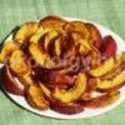 Drying fruits and vegetables is one of the oldest preservation procedure that is unfairly thrust into the background. Today there are several ways to consume fruits and vegetables even in wintertime. (The edible parts of plants may be preserved for example by freezing, cooling, in the form of canned food and various chemical preservatives.)
Drying fruits and vegetables is one of the oldest preservation procedure that is unfairly thrust into the background. Today there are several ways to consume fruits and vegetables even in wintertime. (The edible parts of plants may be preserved for example by freezing, cooling, in the form of canned food and various chemical preservatives.)
In our globalized world “fresh” food flows to us from different parts of the Earth, which are stored in huge freezers after picking, and in many cases are treated with various chemical agents. Then they travel hundreds, even thousands of kilometres to get to the store shelves and become available to the unsuspecting customer. Obviously, this is not the most ideal way to get our vitamins and fibre needs neither from health, nor from environmental point of view.
But even when speaking of dried fruits and vegetables, we should know that the commercially available products (dried fruits and vegetables manufactured by food industry) undergo different treatments. Vegetables are generally treated with sulphur dioxide (E-220), sulphuric acid and its salts (E-221-228). Fruits are preserved by large amounts of sugar added to the water they are cooked in and are made externally attractive for the customer. After all, how can the beautifully packaged dried apples and bananas be as white as snow, sickeningly sweet in taste and have perfect look? Or how can be the various condiments brightly coloured and tastier than “normal”? (Which is due to monosodium glutamate/E-621 by the way.) Although we like dried food for having delicious flavour and being part of a healthy diet, the above examples show that we should be careful with the commercially available products every time.

Solar dryer (Source: zoldbolt.hu)
Therefore, it is time to revive traditional forms of drying, and we ourselves carry out such preservation. In this way, the look of such dried food may be less eye-catching, but we will get food with ingredients that are definitely richer and healthier.
How to dry? Some golden rules…
The two most important criteria for successful drying are that it has to be quick, however, at the lowest temperature possible. The need for being quick is that slow oxidation (i.e. air), occurring at slow drying, adversely affects the colour of the produce (It turns brown!) and also the taste.
Additional tips:
- Any plant can be dried well that has a relatively high dry matter content. (For example, for this reason, it makes no sense to dry melon.)
- Always dry good quality, beautiful, healthy fruit. Avoid defective, windfall, wormy, unripe fruits. It is advisable to dry beautiful, firstling, first-class raw vegetables, too.
- Pay attention to proper preparation of fruits, vegetables (see above!).
- When drying by solar dryer, be careful to keep the dried produce in shade away from direct sunlight. (Only a few products, e.g. cherries, tolerate direct sunshine without damage.) Protect dried fruit and vegetables from the whims of weather (e.g. rain) and pests (e.g. insects), too.
- It is very important to dry in a well-ventilated place, otherwise the product becomes mouldy. ATTENTION! Never eat mouldy fruit. Most moulds produce toxins that cause serious damage to health.
- Put only one layer of fruits or vegetables on the drying surface, otherwise the drying process will be uneven, or the produce may even become stale, start fermenting, and become sour as a result.
- The final product should be removed immediately from the dryer, because if you let the product cool down inside it, then it may dry more than needed, which will adversely affect its quality: it will become too hard, lose colour, glossiness, etc.
- Most of the products coming out of the dryer are in delicate condition, easily breakable. For this reason, immediately after drying they should be put on the air for a few hours to continue drying and thus absorb some water.
- The dried fruit is ready, meaning you can remove it from the dryer, when there is no juice leaking from it, if squeezed. If we take the fruit, vegetable in hand and it feels wet, sticky, then we need to continue drying.
- Before drying it is worth steaming vegetables (except e.g. turnips), or put them for 1-2 minutes in salty water. This helps ensuring preservation, keeps the flavour of vegetables and the dried produce becomes quick and easy to cook. A similar procedure of using lemon juice can be used to prevent fruits from turning brown (e.g. apples), which does not affect the taste, but still contributes to the preservation of bright colours.
